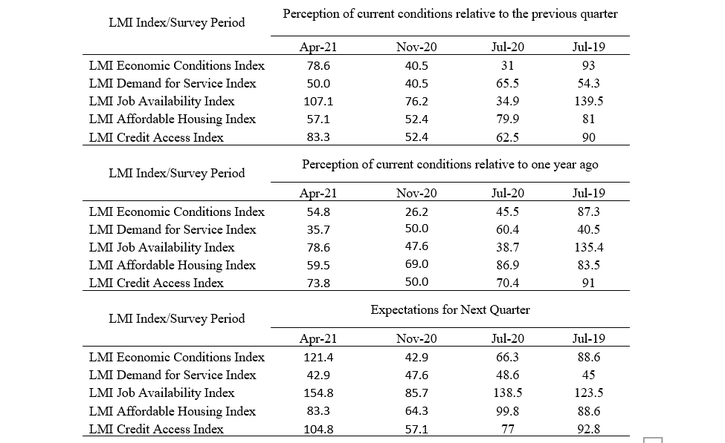Since the last survey in November 2020, the pandemic and its effects have subsided substantially. Case numbers and deaths from COVID-19 are down. Vaccines have become widely available. Meanwhile, the March jobs numbers showed the economy is recovering. Congress also passed the $2 trillion American Rescue Plan in March, providing much-needed assistance to those still struggling through the effects of the pandemic.
This recovery was evident in results of the Low-to-Moderate Income (LMI) Economic Conditions survey conducted March 22 to April 1, 2021, by the Federal Reserve Bank of Kansas City. We also asked respondents special questions this quarter related to the American Rescue Plan Act (ARPA), efforts they are taking to address educational disparities that have grown over the past year, and any efforts they are seeing that are having a noticeable effect on addressing racial equity. In this survey round, we found:
- Economic conditions generally are improving for LMI populations across all categories (Chart 1).
- Indicators of stress remain: the housing situation has not changed, and organizations continue to see a high demand for services.
- Responding organizations expect to see continued high demand for services as funds from ARPA are dispersed. They expect rental assistance and relief checks to have the biggest effects on LMI communities.
- For responding organizations working to address educational disparities, about half are working to provide computers and internet service and the other half are providing training in use of computers and online platforms.
- Most of the efforts to address racial equity involve more open dialogue and training. Some organizations are seeing increased funding opportunities for racial equity.
The survey collects information from nonprofits and other agencies that serve the LMI community in the Federal Reserve’s Tenth District: Colorado, Kansas, western Missouri, Nebraska, northern New Mexico, Oklahoma and Wyoming.
Chart 1: Conditions in LMI communities compared with last quarter; last year; expectations for next quarter
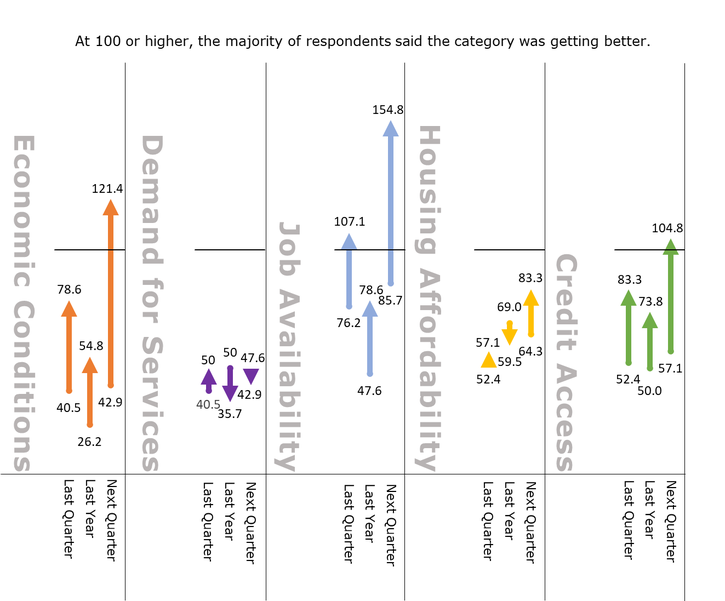
Overall Economic Conditions
Overall economic conditions for LMI populations improved over last quarter and last year. Optimism for LMI economic conditions into next quarter was at record highs for the index. Respondents indicated much of the improvement was related to the third round of relief checks and continuation of expanded unemployment insurance.
Demand for Services
Nearly 65% of respondents reported an increase in demand for their services. This was a slight decrease from the last survey. Primary causes for the increase were the pandemic, continued housing struggles – especially services for those experiencing or near homelessness – and the severe cold weather that struck the District in February.
For nearly two weeks in February, almost all seven states experienced record-breaking cold temperatures, snow, and power outages. Thankfully, as one Oklahoma respondent reported, no one experiencing homelessness in their service area died due to the weather. Not all areas of our District were as fortunate. A Tulsa man experiencing homelessness died on the first night of the severe freeze._ Due to a lack of systematic data collection, it is unlikely there will be an official count of deaths of those experiencing homelessness during February’s weather event.
Most District states are experienced in sheltering people facing homelessness during severe cold. Precautions around COVID-19, however, made that task more difficult as more space is needed to safely shelter a growing homeless population. The Department of Housing and Urban Development found a 2.9% increase over 2019 in people experiencing homelessness across the Tenth District (Table 1). For most District states, this was a reversal of declines of homelessness since 2016. These numbers do not include the effect of the pandemic, as the count was done in January 2020.
Table 1: Tenth District Homeless Counts
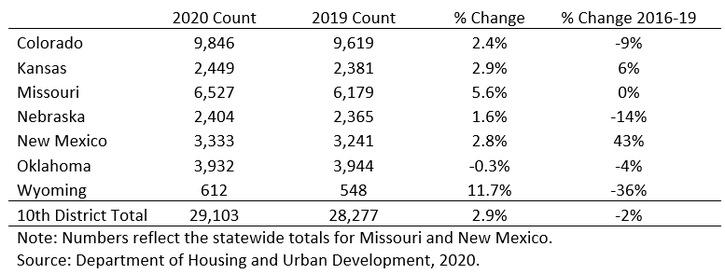
Job Availability
Jobs have been the headline issue during the pandemic. Nationwide, employers added 916,000 jobs in March. That significant increase was evident in our survey as most of our respondents said job availability for LMI populations improved over last quarter. Sixty-two percent of respondents indicated they expect continued improvement in job availability next quarter.
Housing Affordability
The weakest category in this survey was availability of affordable housing. That was expected as unemployment is still high, many LMI households are still struggling, and the threat of evictions looms as the Centers for Disease Control (CDC) eviction moratorium eventually will expire.
Many respondents stated there was a severe shortage of housing affordable for LMI households and that prices in the last year have risen sharply. A recent report showed rents in the lowest-cost neighborhoods nationwide were increasing much faster than the highest rent ZIP codes._ In Kansas City, rents in the lowest cost ZIP codes grew three times faster than in the highest cost ZIP codes, 6.9% and 2.2%, respectively. This is an indication of high demand for lower-cost apartments that is not being met with new construction.
Credit Access
Only 9% of respondents said credit access was improving. Many comments suggested banks still have very tight lending standards. Some comments suggested lending standards are hurting their organization as well as their clients. Most respondents were optimistic that credit access will improve in the near future.
Impact of ARPA
For this survey, we asked respondents how they expect ARPA to affect their work with LMI populations. Most respondents expect to see increased demand for their services as they will be helping people with funds from the legislation (Chart 2).
Chart 2: How do you expect the American Rescue Plan to impact your work with LMI communities?
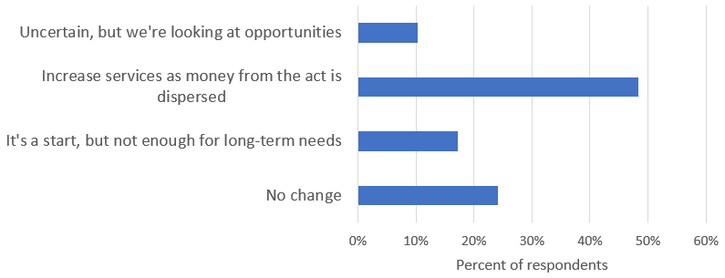
Respondents expect the biggest effect to come from rental assistance and relief checks. Many indicated the aid, while critical and timely, is not enough to address long-term needs.
One statement of concern: “I believe more in the LMI population will be on more sound footing due to ARPA passage and the extension of unemployment checks. However, I feel many in this population don't have access to experts who can help them get the most out of some of these benefits. More communication and outreach is needed to educate this population and guide them through the process.”
Many of ARPA’s programs involve complicated application processes, in addition to issues of awareness that the help exists. A survey of landlords and tenants by Avail (a property management software company) indicated nearly half of landlords and a third of tenants were unaware of the availability of rental assistance funds from the relief bill passed in December._ Outreach efforts and programs that assist people with applying for funds likely will be important to successfully getting money to people who need it.
Addressing Education Effects from the Pandemic
A second special question asked respondents about their efforts to address educational disparities exacerbated by the pandemic. While large gaps in educational outcomes for LMI students already existed, the pandemic brought out additional issues with a rapid shift to online learning without guarantees students had access to reliable internet.__ Most respondents said they are actively involved in providing access to internet, computers, training in technology, or other support services (Chart 3). About half of respondents did not have any programming around the issue, mostly because education and digital divide issues fall outside the scope of their work.
Chart 3: How is your work with LMI communities changing to address educational disparities brought about by the COVID-19 pandemic?
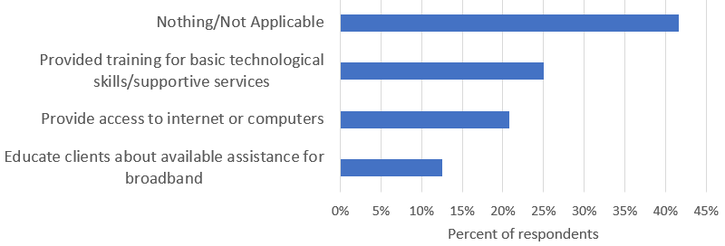
Addressing the digital divide is likely to be a persistent issue following the pandemic. However, because long-term effects are unknown, there likely may be growing needs to address educational disparities beyond the digital divide. As one respondent said, “… we provided supportive services to ameliorate the detrimental effects of the shift to online learning – with varying degrees of success. The long-term impact is yet to be seen.”
Efforts to Address Racial Equity
Aside from the pandemic, 2020 was a year of growing awareness of racial inequality in the U.S. While LMI-serving organizations had to focus much of their efforts on the immediate effect of the pandemic, we wanted to know if any changes they were seeing in their field were having a significant effect on addressing racial equity. Most efforts are related to talking about the issue and providing more training around diversity and inclusion (Chart 4). It is a step toward bigger changes, as one respondent said they are evaluating the diversity of their boards, leadership, staff, donors and suppliers. Whether the more open dialogue and awareness turns into action (e.g., changing diversity of their board) is a larger question that requires more time.
Chart 4: Efforts to Address Racial Equity

Two respondents said bigger changes were apparent. One said, “There are many more very large awards available to vie for and a willingness to think big and longer term to go alongside the much larger grant opportunities.” The other mentioned they are seeing more sophisticated and better-funded companies start up from minority communities.
However, many others are seeing minor changes that currently have little noticeable effect. As one respondent said, “Since the summer of 2020, there have been several initiatives begun to address racial equity issues but none, so far, have led to a noticeable impact.” It may take time for some changes to become apparent. However, others said the changes taking place are not likely to have much effect.
Appendix 1: Diffusion Indexes for LMI Economic Conditions Survey Responses
Diffusion indexes measure the share of respondents responding things are improving versus the share responding things are getting worse. An index value over 100 means most respondents said things were getting better.
